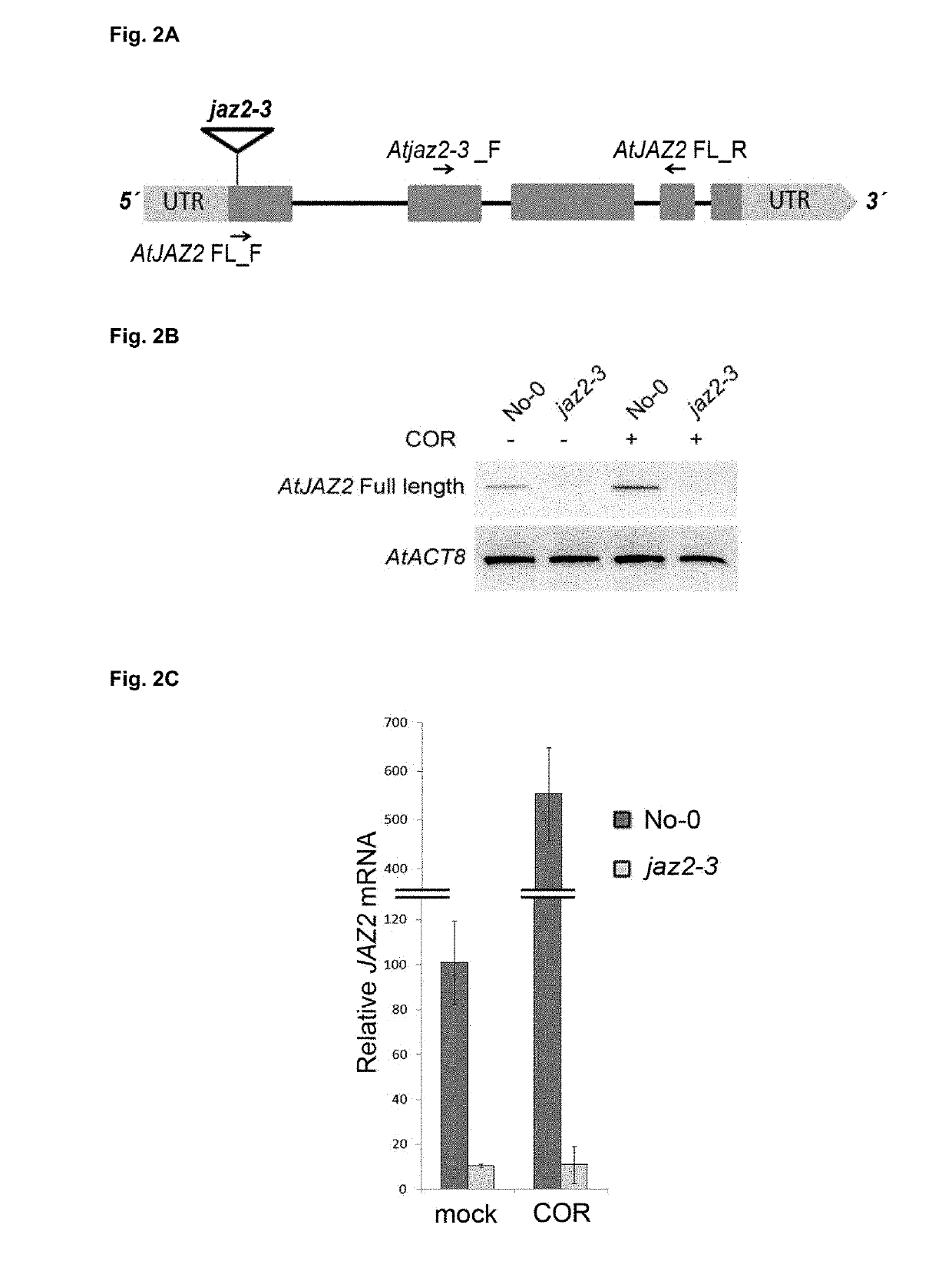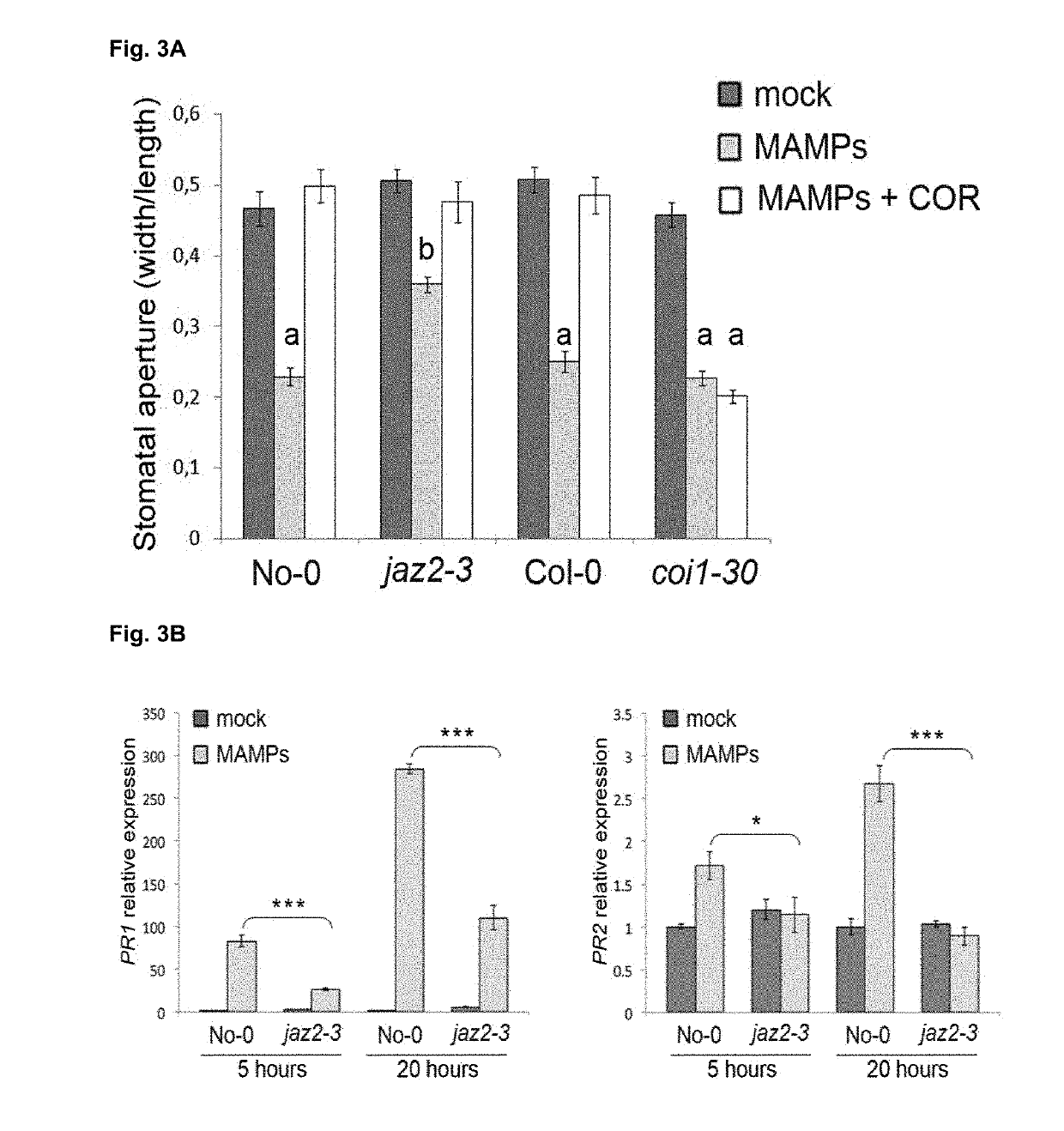Nucleotide sequence for improving resistance against plant pathogens
a plant pathogen and nucleotide sequence technology, applied in the field of nucleotide sequence for improving resistance against plant pathogens, to achieve the effects of high resistance, modulation of stomata aperture, and promotion of infection
- Summary
- Abstract
- Description
- Claims
- Application Information
AI Technical Summary
Benefits of technology
Problems solved by technology
Method used
Image
Examples
example 1
JAZ2 Gene is Expressed in Stomata Guard Cells
[0187]To identify JAZ genes specifically expressed at stomata, inventors produced transgenic Arabidopsis lines harboring a promoter construct covering around 2 Kb upstream of the ATG of each JAZ fused to the p-glucuronidase (GUS) reporter gene. It was successfully obtained stable transgenic plants expressing the corresponding JAZ promoter:GUS fusions for seven out of the twelve JAZ genes (JAZ1; AT1G19180, JAZ2; AT1G74950, JAZ3; AT3G17860, JAZ5; AT1G17380, JAZ6; AT1G72450, JAZ9; AT1G70700 and JAZ12; AT5G20900). Detailed examination of GUS expression driven by JAZ regulatory sequences at the stomata revealed that JAZ2 was the only one among these JAZs expressed in guard cells (FIG. 1). In basal conditions, expression of JAZ2 was exclusive of guard cells, but JA treatment induced it in roots and mesophyll cells of young seedlings, which partially masked the guard cell signal. Histochemical analyses of pJAZ2:GUS transgenics into the coi1-30 b...
example 2
JAZ2 Regulates Stomata Dynamics During Bacterial Pathogenesis
[0188]To test whether JAZ2 function as a regulator of stomatal dynamics during bacterial invasion, it was first obtained an Arabidopsis transposon insertion mutant, designated JAZ2-3 (SEQ ID NO: 12), in the accession Nossen (No-0), and selected homozygous plants (FIG. 2). Gene expression analyses supported that this mutant is a knock-out, or at least a knock-down, since it does not express the full-length JAZ2 gene, and expresses very low levels of truncated mRNA 3′ downstream the insertion (FIG. 2).
[0189]We next analyzed the ability of JAZ2-3 to close stomata upon microbial perception and reopen it in the presence of COR. MAMPs in crude boiled Pto DC3000 bacterial extracts induce stomata closing (Kunze, G. et al. Plant Cell. 2004; 16(12): 3496-3507; Gimenez-Ibanez, S. et al. Plant Signal Behay. 2009, 4(6): 539-54), whereas addition of COR to these extracts promote stomata reopening (Melotto, M. et al. Cell. 2006; 126(5): ...
example 3
Dominant Negative JAZ2ΔJas Mutants are Impaired in COR-Induced Stomata Re-Opening and are Resistance to P.syringae Infections
[0192]To study the specific function of JAZ2 at stomata analyses of dominant-negative JAZ variants were also performed. Truncated JAZ forms lacking the C-terminal Jas domain (JAZΔJas) are resistant to COI1-dependent degradation and behave as constitutive active repressors, blocking the activity of TFs and conferring JA-insensitivity (Chini, A. et al. Nature. 2007; 448(7154): 666-671; Katsir, L. et al. Proc Natl Acad Sci USA. 2008; 105(19): 7100-7105; Sheard, L. B. et al. Nature. 2010; 468(7322): 400-405; Moreno, J. E. et al. Plant Physiol. 2013; 162(2): 1006-1017). To further evaluate the effect of these gain-of-function repressors in stomatal dynamics inventors searched for Arabidopsis T-DNA insertion mutants that would result in JAZ2ΔJas forms under the control of its natural genomic context. It was identified a T-DNA line (GABI collection) that contained an...
PUM
| Property | Measurement | Unit |
|---|---|---|
| Fraction | aaaaa | aaaaa |
| Fraction | aaaaa | aaaaa |
| Fraction | aaaaa | aaaaa |
Abstract
Description
Claims
Application Information
 Login to View More
Login to View More - R&D
- Intellectual Property
- Life Sciences
- Materials
- Tech Scout
- Unparalleled Data Quality
- Higher Quality Content
- 60% Fewer Hallucinations
Browse by: Latest US Patents, China's latest patents, Technical Efficacy Thesaurus, Application Domain, Technology Topic, Popular Technical Reports.
© 2025 PatSnap. All rights reserved.Legal|Privacy policy|Modern Slavery Act Transparency Statement|Sitemap|About US| Contact US: help@patsnap.com



